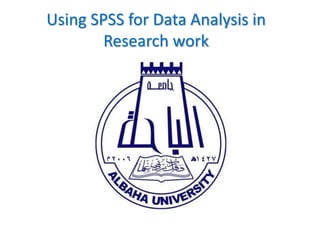
Using SPSS for data analysis in linguistics
- 1. Using SPSS for Data Analysis in Research work
- 2. Step one: Major Points 1- How to enter data 2- What to compute? (PURPOSE) 3- Type statistics measurements (depends) 4- presenting data (graphs or tables) 5- Interpretation of data
- 3. Step two: Input & Output of new data How to begin SPSS :In your computer, SPSS uses two window pages 1-The data editor 2-The viewer
- 4. What is the data editor? This is where you input your data and carry out all statistical analysis. The data editor is composed of two pages: 1- Variable viewer (SPSS Viewer) This is page where you identify your variables. 2- Data view This is where you can see your data and compute it. (Practice)
- 5. What is the Viewer? This is where the results of your analysis appear 1- On the right hand side, there is a large space in which the output is displayed. 2- SPSS displays both graphs and results on this page. 3- You ca edit graphs by clicking on the graph. 4- On the left hand side there is a tree diagram illustrating. (Practice)
- 6. Step three: How to enter data 1- You need to set the characteristics of each variable by entering information into the columns 2- Information in the column include Name, Type, Width, Decimals, Label, Values, Missing, Columns, Align and Measure (details below)
- 7. Information in the column 1. 1-Names 1-Names must begin with a letter. 2-Names must not end with a period. 3-Names must be no longer than eight characters. 4-Names cannot contain blanks or special characters. 5-Names must be unique. 6-Names are not case sensitive. It doesn’t matter if you call your variable CLIENT, client, or CliENt. It’s all client to SPSS.
- 8. Information in the column 2-Type: Use different types of data; Dependent on variable type numeric (numbers) / string (containing letters)/ currency ($) 3-Width: preferred (8) 4-Decimals: select (2) 5- Label: restrictions in the characteristics of variables
- 9. Information in the column This column for assigning numbers to represent group of people. 6- Missing This column is for assigning number to missing data
- 10. Information in the column 7- Column This for the width of the column. That is to say how many characters should appear in the column. This different from the width which determines the width of the variable itself. 8- Alignment: left/ right/ centered 9- Measure: nominal/ ordinal/ scale
- 11. Hierarchy of measurement scales • Nominal: category labels – allows counting only (incidence, frequencies) • Ordinal: rank order data – distances between consecutive numbers are not necessarily equal – arithmetic operations are meaningless • Interval: – real numners, but with arbitrary 0-point – ratio's are meaningless • Ratio: – as interval, but with natural 0-point – ratios are meaningful
- 12. String & Numeric variables 1- String variable This consists of names, e.g. a student/ lecturer, job, income, etc. 2- Numeric variable This refers to variables you want view as numbers/ figures Notice: if your data is words/ letters click on string variable but if your data is numbers click on numeric variable
- 13. Step four: Descriptive statistics Data analysis Descriptive statistics: – How to compactly summarize a lot of numbers (measurements)? See details below
- 14. Measures • Central tendencies – Mode – Median – Mean • Excentricity – Range – Interquartile range – Standard deviation & variance
- 15. Variables • In terms of mathematical properties – Discrete • e.g. sex: male/female • word length: 1, 2, 3, ... n letters – Continuous • There is always a value in between two other values, e.g. vowel duration, age
- 16. Variables • in terms of methodological function – Independent: stimulus variable – Dependent: response variable The effect of X on Y independent ~ dependent
- 17. A two-dimensional graph has two axes called the X and Y
- 18. A two-dimensional graph has two axes called the X and Y
- 19. Central measures • Mode – Most frequent value (or bracket of values) of a variable – Can be used even for nominal variables
- 20. Central measures • Median – The middle value after all scores have been rankordered (or mid of two middle values if the number of scores is even) – Can be used for rankorder data or higher – Cuts distribution into two equal halves (in terms of surface) – Relatively insensitive to skewed distributions
- 21. Step five: Inferential statistics Inferential statistics: – How accidental are the differences that I find – What is the chance of drawing the wrong conclusion?
- 22. Inferential statistics • 2- Experimental studies 1-Independent variable under experimenter’s control 2- Manipulation of reality in laboratory 3-Cause and effect can be distinguished
- 23. Inferential statistics General strategy 1- Assume that the two samples have been drawn from the same population 2- There should be no difference between the sample means m1 = m2 3- This is called the null-hypothesis H0 4- If the chance of obtaining both samples from the same population is less than 5%, then reject the null-hypothesis and accept the alternative hypothesis H1
- 24. References • Field, R. (2010).Describing Statistics Through SPSS